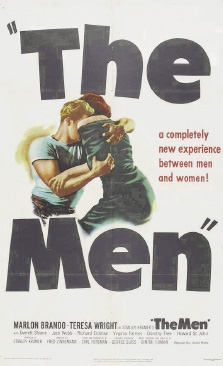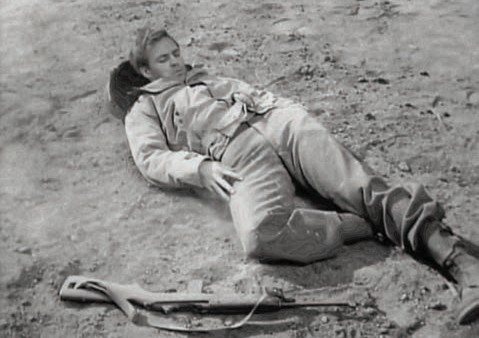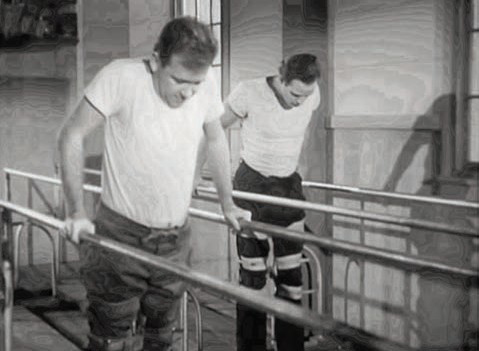Mi SciELO
Servicios Personalizados
Revista
Articulo
Indicadores
-
 Citado por SciELO
Citado por SciELO -
 Accesos
Accesos
Links relacionados
-
 Citado por Google
Citado por Google -
 Similares en
SciELO
Similares en
SciELO -
 Similares en Google
Similares en Google
Compartir
Revista de Medicina y Cine
versión On-line ISSN 1885-5210
Rev Med Cine vol.16 no.3 Salamanca jul./sep. 2020 Epub 16-Nov-2020
https://dx.doi.org/10.14201/rmc2020163185191
ORIGINALS
The Men (1950) by Fred Zinnemann: Paraplegia and main protagonists in the rehabilitation of a disability
1Facultad de Medicina Humana. Universidad Privada Norbert Wiener (Perú).
The Men (1950) by Fred Zinnemann and starring Marlon Brando, is a movie that shows the story of Lieutenant Ken Wilcott, who suffers from paraplegia due to a gunshot wound in the back when he was on duty in World War II. With the help of Dr. Brock and his fiancée Ellen he manages to overcome his disability and begin his process of acceptance and rehabilitation. Through the film we can see the process suffered by patients with disabilities, from denial and depression to finally accept their disability and set out to establish a good future. In the same way, we discuss the importance of the main characters and their functions around a disability: the patient, the doctor, the family and society.
Keywords: disability; paraplegia; rehabilitation; discrimination
Technical Details
Original title: The Men.
Country: United States.
Year: 1950.
Director: Fred Zinnemann.
Music: Dimitri Tiomkin.
Photography: Robert De Grasse.
Film editor: Harry Gerstad.
Screenwriter: Carl Foreman.
Cast: Marlon Brando, Teresa Wright, Everett Sloane, Jack Webb, Richard Erdman, Arthur Jurado, Virginia Farmer, Dorothy Tree, Howard St. John, Nita Hunter, Patricia Joiner, …
Color: Black and white.
Rumtime: 85 minutes.
Genre: Drama, Disability.
Language: English.
Production Companies: Stanley Kramer Productions.
Synopsis: «Ex-GI Ken who as a result of a war wound is paralyzed below the waist. In the hospital back home, he passes through an initial period of depression with the help of a sympathetic Dr. Brock and his faithful fiancée Ellen. Ken's bitter isolation is also overcome with the help of his fellow patients (...) With the approval and help of the doctor, he and Ellen marry, but on their wedding night both have misgivings about the marriage (...) after a surprising conversation with Dr. Brock, Ken realizes that he must return to his wife, with whom he must try to build his new life, in spite of all the attendant difficulties». (IMDb).
Links:
https://www.imdb.com/title/tt0042727 https://www.filmaffinity.com/es/film
Introduction
Paraplegia is the severe or complete loss of motor function in the lower extremities due to a spinal cord injury mainly due to trauma. The etiology is led by car accidents, falls, contact sports and gunshot wounds. This last factor is constantly increasing, previously due to the existing war conflicts and nowadays due to the increase in violence and insecurity in cities.
Fred Zinnemann's film The Men (1950) revolves around the life of Lieutenant Ken Wilcott on his return to his country after being paralyzed by a gunshot in World War II (Photo 1). Lieutenant Wilcott, played by Marlon Brando, suffers all the events that trigger a trauma of such magnitude, from denial, anger, depression and subsequent acceptance. The character has the intrigue of not being able to live a «normal» life and therefore, at the beginning, does not want to perform any type of physical rehabilitation by surrendering to continuous prostration accompanied by anger and disappointment for life.
Subsequently, with the help of Dr. Brock and his fiancée Ellen, he manages to accept his disability and overcome it, complying with strict physical rehabilitation, strengthening his psychological condition and smiling at life. As a result, he achieves medical discharge, marries Ellen and then they build their own home.
In this article, it is proposed to reflect on the issues concerning paraplegia, from the medical aspect, addressing its etiology, clinical and main complications; the psychological aspect, because it is a trauma for the patient to understand and accept that he will not use his legs again; Finally, on the main characters involved, the patient, the doctor, the family and society from the point of view that is proposed in the film.
Paraplegia
Paraplegia is the severe or complete loss of motor function in the lower extremities and in the lower portions of the torso as a result of spinal injury or congenital disease1. Penetrating trauma accounts for 13% to 17% of all spinal injuries2. In the United States, the most common cause of spinal cord injury is traffic accidents followed by a fall from a height. Third, there are firearm injuries. It should be noted that spinal cord injuries due to gunshot wounds occur as a result of direct traumatic effects3.
Pain is probably the most common long-term complication and is quite frequent in cases of involvement of the cauda equina and the conus medullaris. Bullet removal is not associated with pain resolution. It is usually managed with medications, such as tricyclic antidepressants and anticonvulsants4. Another problem related to the bullet is metal toxicity, particularly lead. Systemic lead poisoning, also called saturnism, is a rare complication but it can happen in cases where the bullet remains lodged in the spine5. Meningitis is a complication inherent in trauma and surgical treatment is considered a risk factor. Neurogenic bladder and urinary tract infection are other common complications. Another possible complication is projectile migration, which may or may not cause changes in neurological function6.
About the patient
Paraplegia involves a serious physical disability which will affect the quality of life of patients. This condition is associated with abnormal levels of psychological morbidity, substance abuse and suicide risk7. It is not surprising such behavior due to the anxiety of not being able to use the legs again. In the film, Lieutenant Wilcott meditates to himself: «I was afraid of dying and now afraid of living».
According to the Kübler-Ross model8, there are five phases of grief: denial, anger, negotiation, depression and acceptance; and not all the phases and the proposed order are necessarily fulfilled. Although this model is more characteristic in terminal patients, it can also be adjusted for patients who have suffered a considerable loss (in this case, walking).
There is an evolution in Lieutenant Wilcott's thinking: «The war is over, and I'm glad to be half alive. I'm a lucky guy». This translates the negotiation stage, in which the situation is partially accepted with conditions and there is hope in postponing death. As for the acceptance stage, it is not necessarily consolidated with words, but with actions. It can be seen that the lieutenant accepts his disability, but at the same time he understands that it does not necessarily have to be an inability, so he starts with his physical exercises as part of the rehabilitation scheme (Photo 2), he begins to be more sociable with the hospitalization roommates accept the fact that he must use a wheelchair for the rest of his life, he returns to contact with his fiancée (whom he had taken away for shame of not being able to walk) and finally they get married.
It is important to keep in mind that the acceptance stage will not come quickly and does not mean that it will be generated spontaneously. It is the combination of several psychological factors that strengthen patient support, in which family, medical team and friends play an important role.
About the figure of the doctor
Paraplegia encompasses continuous physical pain and constant emotional stress with changes in the emotional, cognitive and behavioral levels. While physical pain (and complications of paraplegia) can be managed with surgery or pharmacotherapy, the emotional factor remains as an important part in the patient's complete recovery.
An important role in that recovery is the trust that can be forged between the patient and the doctor. And it is that the doctor-patient relationship, when it is correct, is considered a type of friendship, a medical friendship, where the doctor brings his knowledge and intention to help and the patient brings his trust and hope in the attending doctor9. A doctor-patient relationship following the precepts of patient-centered care is an important resource that can lead to greater resilience and recovery10.
Nevertheless, it should be noted that the management of a patient with spinal cord injury and paraplegia is multidisciplinary, where different specialist doctors (neurologist, neurosurgeon, physiatrist, psychiatrist), nurses, rehabilitators, etc. They all have an important role in the evolution of the patient. It would not be surprising if at some point a type of interpersonal relationship is established, not the doctor-patient dualistic relationship, but a relationship between the medical team and the patient.
In the film, the doctor in charge of the rehabilitation process of patients with gunshot wounds and subsequent involvement of the spinal cord is Dr. Brock, who in medical visits not only highlights strictly medical matters but also covers personal issues with patients like their life projects after the war, the future, their studies, their families, etc. (Photo 3). A solid relationship with patients is thus forged, earning their charisma and trust. «We are proud of you», «How is the family doing?», «Have you decided what you will do when you leave?» Or «With patience everything comes in this life» are some of the phrases that are listen to Dr. Brock throughout the medical visit motivating his patients to adhere and collaborate with the rehabilitation treatment and have a purpose that motivates them to move forward.
About the family
The family plays an equally important role, since it is the closest entity by nature to the patient. In one study, the importance of commitment by family members in the recovery of patients with chronic pain was demonstrated11. Family members must always be attentive to the needs of the patient, for example, in their activities of daily living, which some of them will require support. Likewise, they should pay attention to the warning signs of possible complications and be instructed about the patient's condition. The family constitutes the emotional support in the recovery of the patient; therefore communication between the members should be strengthened.
The film shows how the relatives of the patients, especially the wives, commit themselves to the disability possessed by paraplegic patients, attending informative talks by Dr. Brock (Photo 4). The questions asked by family members focus on a possible cure, age, children, patient behavior. Age is a frequent question in paraplegia since the majority of patients in the film (and in real life) are young adults. «My son is 19 years old» says a worried mother to Dr. Brock and he replies: «I know, but if he takes care of himself he can reach 90». Another question asked by a wife is: «Is it possible to have another child?» The doctor replied: «It is difficult to say; in many cases it is possible». Another question is: «I want to continue together with my husband, but he has changed so much, he is another person». Dr. Brock responds: «No, he is not another person. He is the same man, now with a spinal injury, only that he is depressed (...) It's all about time and patience».
About society
It is a fact that the person with disabilities, like any other person, is a product of their social interaction with the environment. That is, society plays a fundamental role in the recovery and reintegration of the patient12. In the particular case of people with complete spinal cord injury, unable to use their legs, they will be obliged to use a wheelchair for their displacement. Are most cities equipped for the proper transfer of people in wheelchairs? It is an obstacle to the use of means of transport such as the bus, tram or subway, which, in most cases (at least in developing countries); do not have a ramp that allows access for these people. To this is added the indifference of the drivers of these services that urge the person to take a taxi because they would find it easier, generating greater economic expense in the patient, which apart from his medical treatment, also has to ensure his displacement. Do the sidewalks have a wheelchair access ramp? Similarly, that the transport system, the main pedestrian routes must meet this requirement and at the same time be free of any obstacle that hinders the correct movement of people with disabilities, for example, street lighting poles in the middle of the sidewalk.
No less important is the sensitivity of people. It is necessary to make an analysis of collective behavior towards people with some type of disability, whether physical, sensory or intellectual. Justice is achieved at the moment that everyone is recognized as equal in dignity. However, justice is also equity. Everyone should not be treated equally when we are already different. That would mean a huge injustice. The disabled person, the sick, even the elderly require differentiated treatment because of their situation13. In recent decades, the emergence of organizations and support groups that promote the integration of people with disabilities has been contemplated. Additionally, laws that promote and protect the conditions of equal rights of persons with disabilities have been created and strengthened, thus consolidating their effective inclusion in society. The concept of integration is embodied in the film through the help provided by patients who are members of the Paralyzed Veterans of America (PVA) and also when Lieutenant Wilcott marries his fiancée Ellen and together they build their house, laying the foundations for a new future (Photo 5 and Photo 6).
Conclusion
The human being is fascinating to host contrasts of light and shadow. Does the stigma of discrimination against people with disabilities still persist? Is the concept that disability is equal to inability still associated? The only way to change this thinking is through education, which must be comprehensive, tolerant and promotes of peace. The film The Men (1950) manages to transmit that path that people who suffer from disabilities pass, in this case, paraplegia. We must reflect on the indifference that persists in front of people with disabilities, to maintain and strengthen our humanity, that capacity that allows us to feel affection, understanding and solidarity towards other people. And it is in these times, governed by social networks and dominated by superficiality and appearance that makes society more frivolous, where values are needed more than ever, ceasing to be an ideal concept for them to become a reality.
Referencias
1. Hidalgo-Martinez A. La rehabilitación terapéutica a pacientes parapléjicos: impacto desde las tecnologías. PODIUM-Revista de Ciencia y Tecnología en la Cultura Física. 2017; 12(1): 21-30. http://podium.upr.edu.cu/index.php/podium/article/view/687 [ Links ]
2. de Barros Filho TE, Cristante AF, Marcon RM, Ono A, Bilhar R. Gunshot injuries in the spine. Spinal Cord. 2014; 52(7): 504-10. http://podium.upr.edu.cu/index.php/podium/article/view/687 [ Links ]
3. Devivo MJ. Epidemiology of traumatic spinal cord injury: trends and future implications. Spinal Cord. 2012; 50(5): 365-72 https://www.nature.com/articles/sc2011178.pdf [ Links ]
4. Spaić M, Petković S, Tadić R, Minić L. DREZ surgery on conus medullaris (after failed implantation of vascular omental graft) for treating chronic pain due to spine (gunshot) injuries. Acta Neurochir (Wien). 1999; 141(12): 1309-12 [ Links ]
5. Cristante AF, de Souza FI, de Barros Filho TE, Oliveira RP, Marcon RM. Lead poi- soning by intradiscal firearm bullet: a case report. Spine (Phila Pa 1976). 2010; 35(4): 140-3 [ Links ]
6. Aarabi B, Alibaii E, Taghipur M, Kamgarpur A. Comparative study of functional recovery for surgically explored and conservatively managed spinal cord missile injuries. Neurosurgery. 1996; 39(6): 1133-40 [ Links ]
7. Post MWM, van Leeuwen CMC. Psychosocial issues in spinal cord injury: a review. Spinal Cord. 2012; 50(5): 382-89 https://www.nature.com/articles/sc2011182.pdf [ Links ]
8. Miaja-Avila M, Moral de la Rubia J. El significado psicológico de las cinco fases del duelo propuestas por Kübler-Ross mediante las redes semánticas naturales. Psicooncología. 2013; 10 (1): 109-30https://revistas.ucm.es/index.php/PSIC/article/view/41951/39953 [ Links ]
9. Mendoza A. La relación médico paciente: consideraciones bioéticas. Rev Peru Ginecol Obstet. 2017; 63(4): 555-64 http://www.scielo.org.pe/scielo.php?script=sci_arttext&pid=S2304-51322017000400007 [ Links ]
10. Náfrádi L, Kostova Z, Nakamoto K, Schulz PJ. The doctor-patient relationship and patient resilience in chronic pain: A qualitative approach to patients' perspectives. Chronic Illn. 2018; 14(4): 256-70 [ Links ]
11. Mawdsley L, Twiddy H, Longworth M. Involvement of Family and Friends in Pain Management Interventions. Journal of Observational Pain Medicine. 2015; 1(5): 12-21 https://www.researchgate.net/publication/292986884_Involvement_of_Family_and_Friends_in_Pain_Management_Interventions [ Links ]
12. Kurawa SS. The impact of disability on self and society: an agenda for research on rehabilitation of disabled in Nigeria. Procedia Social and Behavioral Sciences. 2010; 5: 1804-10 https://www.sciencedirect.com/science/article/pii/S1877042810017428 [ Links ]
13. Ortega-Ruiz P. La construcción de la paz. Revista Virtual Redipe. 2016; 5(13): 17-35https://revista.redipe.org/index.php/1/article/view/31/29 [ Links ]
Received: January 02, 2020; Accepted: January 16, 2020; pub: September 15, 2020
 Licencia CC BY-NC-ND.Licencia Creative Commons Atribución-NoComercial-SinDerivar 4.0 Internacional
Licencia CC BY-NC-ND.Licencia Creative Commons Atribución-NoComercial-SinDerivar 4.0 Internacional











 texto en
texto en 








